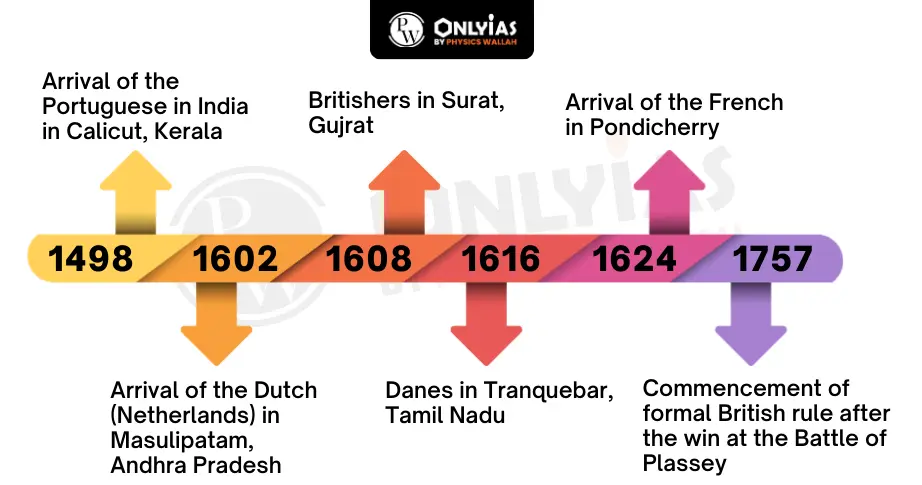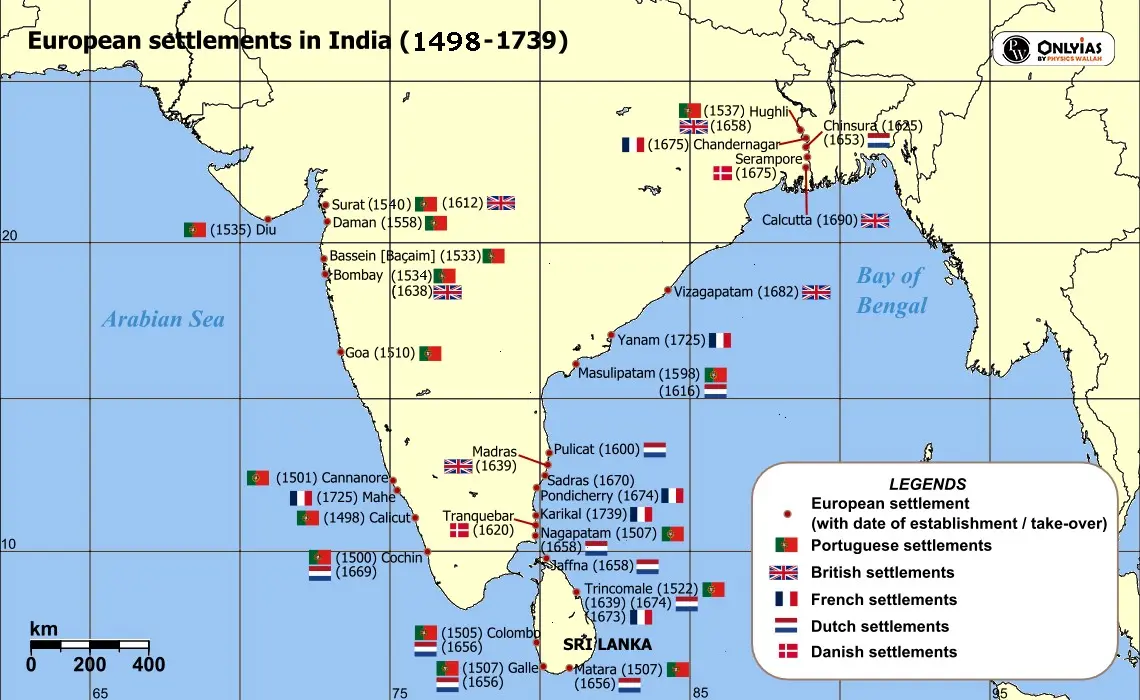Advent of Europeans in India: Trade, Colonization, and Societal Shifts # |
Impact of European Advent in India: Shaping Society, Economy & Polity #
In 1498, the Portuguese adventurer Vasco da Gama arrived at the coasts of India, initiating a period of Advent of Europeans in India. This was soon intensified by the pursuits of other European nations such as the Dutch, English, and French, all vying for trade supremacy and territorial ownership. The Advent of Europeans in India powers profoundly impacted India’s trajectory, leaving enduring marks on its societal, economic, and political spheres.
 #
#
Reasons for Advent of Europeans in India: Goods, Taxes & Profit Strategies #
- Demand of Goods: The high demand for Indian goods in Europe necessitated a complex journey through various regions and intermediaries.
- High Taxes: As these valuable commodities made their way to Europe, rulers in the Middle East and North Africa imposed tariffs and taxes on these imports.
- Increasing Profitability: To enhance their profitability, European trading companies sought to create their own trading hubs within India, leading them to opt for direct voyages to the Indian subcontinent.
Portuguese in India: Colonial Pioneers and Lasting Presence #
- The arrival of the Portuguese started the advent Of Europeans in India and it marked the beginning of European colonialism in the subcontinent.
- The Portuguese were the First Europeans to come to India and the last one to leave.
Voyage to India: Colonial Impact on the Indian Subcontinent #
- Arab Trade Route Domination: After the Roman Empire’s decline and Constantinople’s fall in 1453, Arabs gained control in Egypt and Persia, overseeing the trade routes to India.
- European exploration: European interest in sea explorations surged in the 15th century which inspired by Renaissance spirit and advancements in shipbuilding and navigation
- Territorial division: Treaty of Tordesillas (1494) divided the non-Christian world between Portugal and Spain.
- Portugal: Granted eastern territories
- Spain: Granted western territories
- Impact: This division paved the way for Portuguese explorations near India.
Portuguese Influence in India: Routes, Conquests, and Transformations #
- New Route: The new naval route from around the cape of Good Hope, provided the Portuguese an alternative route outside the traditional Arab dominated route, and it was the first factor leading to Advent of europeans in india
- European Entry: For the first time in the political history of Advent Of Europeans in India conquered and seized territories from the Indian rulers.
- New crops: The Portuguese introduced several crops to India like pineapple, papaya, cashew nuts, chilies and tobacco.
- Inter-racial marriage: The marriages between Europeans and Indians, encouraged by the Portuguese in the territories occupied by them, created a new Eurasian racial group.
- Introduction of Printing press: The printing press was introduced in India by Portuguese traders in the 16th century.
- Cartaz System: It was oppressive for Indian merchants as it limited their mobility and commercial activities while increasing costs.
 #
#
Dutch East India Company: Power, Authority, Colonial Dominance #
- Establishment: The Dutch East India Company, also referred to as Verenigde Oostindische Compagnie, was founded in 1602.
- Authorities to Company: The company held the authority to wage war, finalize treaties, claim territories, and build fortresses.
Dutch Rivalry in India: Outposts, Seizures, and South India Base #
- Setting Trading Outposts: They challenged Portuguese dominance by setting up trading outposts in areas such as Gujarat, Bengal, Bihar, and Orissa.
- Seized Nagapadam: They seized Nagapadam near Madras from the Portuguese, making it their primary base in South India.
- Initial Footing: The Dutch set up their first factory in Masulipatnam (Andhra) in 1605.
The Dutch(Advent Of Europeans in India): British Rivalry and Territorial Shifts #
- Dutch Colonial Decline: By the middle of the 18th century, the Dutch started experiencing a decline in their authority in the Indian subcontinent, largely due to the unwavering colonial endeavors of their British adversaries.
- Battle of Colachel: The pivotal moment came in 1741 with the Battle of Colachel, which conclusively marked the end of Dutch influence in South India when the Travancore army triumphed over the Dutch East India Company’s forces.
- Territorial Relinquishment: Subsequently, the Dutch began relinquishing their territories to the British, and the Anglo-Dutch Treaty of 1814 expedited the decline of Dutch colonial rule in India.
East India Company: Exclusive Charter and Monopoly Extension #
- Establishment: On December 31, 1600, Queen Elizabeth I granted the ‘Governor and Company of Merchants of London trading into the East Indies’ an exclusive trading charter.
- Initially given a 15-year monopoly, this privilege was eventually extended with no end date.
British Advancement: West, South, and Bengal Growth #
| Area of Expansion | Key Events |
| West and South |
|
| Bengal |
|
Danes(Advent of Europeans in India) in India: Trading Ventures and Missionary Legacy #
- Establishment: The Danish Asiatic Company was set up in 1616, and by 1620, they had established a factory in Tranquebar, close to Tanjore, on India’s eastern coast.
- Main Center: Serampore near Calcutta was their main settlement.
- The Danish trading posts, which never gained significant prominence, were acquired by the British in 1845.
- Missionary Endeavors: The Danes are more recognized for their missionary endeavors than their trading activities.
French in India: Company Founding, Last Traders, Wars #
- Foundation: The foundation of Compagnie des Indes Orientales (The French East India Company) in 1664 was laid down by Jean-Baptiste Colbert, a minister in the court of Louis XIV.
- Last Europeans: The French were the last Europeans to reach India as traders.
- First Factory: The first French factory at Surat was established by Francois Caron in 1668.
- Anglo-French Struggle:
- The Anglo-French rivalry in India was characterized by fierce competition and conflicts between the two colonial powers.
- Carnatic Wars: This competition in India played out through a series of three Carnatic wars, ultimately establishing English dominance over the French as the rulers of India.
Conclusion: #
- The advent of Europeans in India and their exploration, colonization, and interactions with Indian populations had far-reaching and often complex consequences.
- Further, European powers engaged in intense competition, leading to conflicts and power struggles in India.
Previous Years Question #Q. In the first quarter of the seventeenth century, in which of the following was/were the factors/factories of the English East India Company located? (2022)
Select the correct answer using the code given below.
Answer (a). Mains: Q. Why did the armies of the British East India Company – mostly composed of Indian Soldiers – win consistently against the more numerous and better-equipped armies of the then-Indian rulers? Give reasons. (2022) |
Also Read: Unravelling the Factors Behind the Portuguese in India

 GS Foundation
GS Foundation Crash Course
Crash Course Combo
Combo Optional Courses
Optional Courses Degree Program
Degree Program












